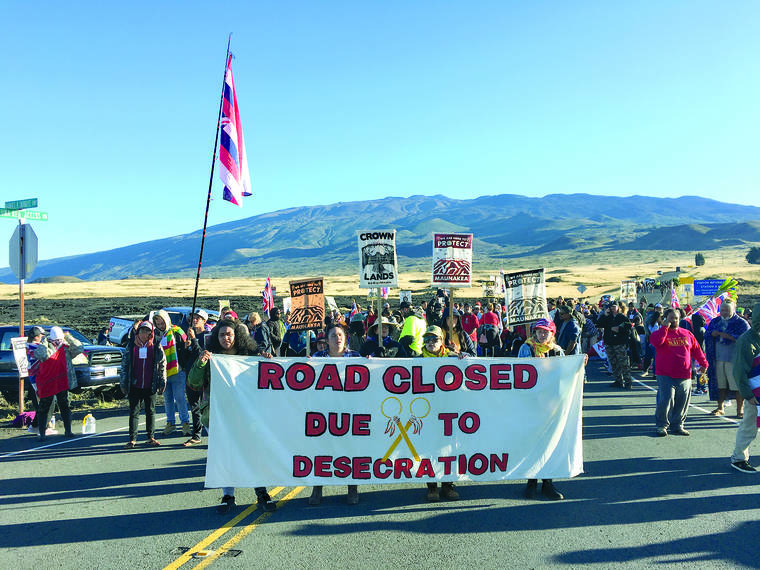UH regents unveil Maunakea resolution

A new resolution proposed by members of the University of Hawaii Board of Regents would establish deadlines for the decommissioning of several Maunakea telescopes and set groundwork for future educational programs on the mountain.
A new resolution proposed by members of the University of Hawaii Board of Regents would establish deadlines for the decommissioning of several Maunakea telescopes and set groundwork for future educational programs on the mountain.
The resolution was published online Tuesday and was drafted by the Board of Regents’ Maunakea Governance Permitted Interaction Group, which was formed in August to identify issues relating to the university’s stewardship of Maunakea activities.
ADVERTISING
The preamble to the resolution acknowledges that “any mismanagement of Maunakea is hurtful and disrespectful to the sanctity and inviolability of this place to Native Hawaiians and others,” but the resolution itself pointedly does not directly mention the Thirty Meter Telescope, the catalyst for much of the current debate regarding Maunakea management.
UH spokesman Dan Meisenzahl said the resolution allows the board — many of whose members were not on the board when the first permit applications for TMT were filed in 2010 — to publicly declare where it stands on various Maunakea-related issues and demonstrate how it plans to go forward, although he emphasized that the resolution has not yet been approved. The board could pass, discard, amend or delay the resolution as it sees fit during its next meeting in November,
“The dynamic of the issue has changed since 2010. It’s changed even since the July protests started,” Meisenzahl said, referring to the ongoing protest by Native Hawaiians and others against construction of the TMT.
Among the positions outlined by the resolution are commitments to firm deadlines for the decommissioning of four of the five summit telescopes scheduled to be removed. The first two sites, the Caltech Submillimeter Observatory and UH’s Hoku Ke‘a educational observatory, are to be cleared and restored to their natural state no later than April 30, 2021.
The resolution also requests that a timeline for the decommissioning process for those two sites be presented to the regents no later than its meeting in February.
The United Kingdom Infrared Telescope is similarly scheduled to be decommissioned by December 2024, with a schedule to be provided by the end of 2022.
The fourth site, the Very Long Baseline Array, already is scheduled to be removed by the end of 2033, and the fifth and final telescope to be decommissioned will be identified by the end of 2022.
Meisenzahl said the dates identified in the resolution are not significantly different from projected dates the university has already known.
The resolution also makes several commitments to increase educational programs on and around Maunakea.
The university’s educational telescope is to be reopened at Halepohaku or elsewhere on the island no later than April 30, 2021, and the resolution also advises that UH administration request capital improvement funding from the state Legislature next year to design and build an educational center at Halepohaku.
Meisenzahl said the resolution has some goals in common with a proposal drafted by Mayor Harry Kim several weeks ago, which also called for an educational and cultural center to be built on Maunakea.
“A lot of the stuff the mayor’s been saying, UH has been saying for years,” Meisenzahl said. “I certainly think this resolution leaves space for the mayor’s proposal … I think the board is stating similar things. This and the mayor’s plan are complementary.”
The resolution also proposes a reorganization and restructuring plan that would make Maunakea governance operations more efficient and transparent, including an analysis of whether management would be better served by transferring authority to the government or a third party. That plan will be presented to the board by April 2020.
Among the other items in the resolution is a proposed collaboration with the Office of Maunakea Management and Maunakea Support Services to develop educational programs at ‘Imiloa Astronomy Center intended to instruct summit workers and visitors about Native Hawaiian culture and other environmental considerations at the summit, language clearly intended to address criticism that the university’s management of the mountain has mistreated land culturally significant to the Hawaiian community.
Other items include a proposed cooperation with the Department of Hawaiian Home Lands to resolve lingering jurisdictional issues regarding the Maunakea Access Road and a possible partnership with an appropriate Native Hawaiian organization to operate commercial shuttles and tours on Maunakea.
Noe Noe Wong-Wilson, a leader among the TMT protesters, said she thinks it is “unfortunate” that the resolution was formulated without input from some members of the Native Hawaiian community.
“I think the people who should be at the table are the petitioners who have been talking about Maunakea management this whole time, as well as some of us kia‘i,” Wong-Wilson said, using a Hawaiian word meaning “protector,” the preferred nomenclature of the TMT protesters.
Wong-Wilson also criticized the absence of any language regarding TMT.
“I expect the assumption in this resolution is that TMT will just be there,” Wong-Wilson said.
The full Board of Regents will choose whether to adopt the resolution during its next meeting, which is scheduled for Nov. 6 at UH-Hilo. During that meeting, the board also is expected to make a decision regarding proposed changes to the university’s Maunakea administrative rules. Members of the public are able to testify during the meeting.
The full text of the resolution can be found at hawaii.edu/news/2019/10/15.
Email Michael Brestovansky at mbrestovansky@hawaiitribune-herald.com.


